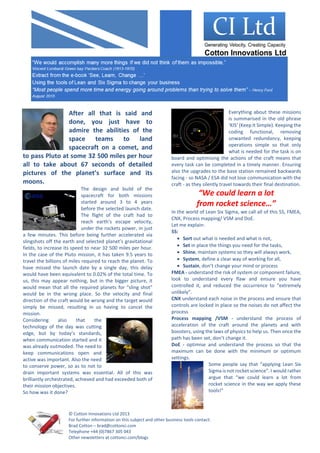More Related Content
Similar to Facing the impossible and making it posssible
Similar to Facing the impossible and making it posssible (20)
Facing the impossible and making it posssible
- 1. © Cotton Innovations Ltd 2013
For further information on this subject and other business tools contact:
Brad Cotton – brad@cottonci.com
Telephone +44 (0)7867 305 043
Other newsletters at cottonci.com/blogs
After all that is said and
done, you just have to
admire the abilities of the
space teams to land
spacecraft on a comet, and
to pass Pluto at some 32 500 miles per hour
all to take about 67 seconds of detailed
pictures of the planet’s surface and its
moons.
The design and build of the
spacecraft for both missions
started around 3 to 4 years
before the selected launch date.
The flight of the craft had to
reach earth’s escape velocity,
under the rockets power, in just
a few minutes. This before being further accelerated via
slingshots off the earth and selected planet’s gravitational
fields, to increase its speed to near 32 500 miles per hour.
In the case of the Pluto mission, it has taken 9.5 years to
travel the billions of miles required to reach the planet. To
have missed the launch date by a single day, this delay
would have been equivalent to 0.02% of the total time. To
us, this may appear nothing, but in the bigger picture, it
would mean that all the required planets for “sling shot”
would be in the wrong place. So the velocity and final
direction of the craft would be wrong and the target would
simply be missed, resulting in us having to cancel the
mission.
Considering also that the
technology of the day was cutting
edge, but by today’s standards,
when communication started and it
was already outmoded. The need to
keep communications open and
active was important. Also the need
to conserve power, so as to not to
drain important systems was essential. All of this was
brilliantly orchestrated, achieved and had exceeded both of
their mission objectives.
So how was it done?
Everything about these missions
is summarised in the old phrase
‘KIS’ (Keep It Simple). Keeping the
coding functional, removing
unwanted redundancy, keeping
operations simple so that only
what is needed for the task is on
board and optimising the actions of the craft means that
every task can be completed in a timely manner. Ensuring
also the upgrades to the base station remained backwards
facing - so NASA / ESA did not lose communication with the
craft - as they silently travel towards their final destination.
“We could learn a lot
from rocket science…”
In the world of Lean Six Sigma, we call all of this 5S, FMEA,
CNX, Process mapping/ VSM and DoE.
Let me explain:
5S:
Sort out what is needed and what is not,
Set in place the things you need for the tasks,
Shine, maintain systems so they will always work,
System, define a clear way of working for all,
Sustain, don’t change your mind or process
FMEA - understand the risk of system or component failure,
look to understand every flaw and ensure you have
controlled it, and reduced the occurrence to “extremely
unlikely”.
CNX understand each noise in the process and ensure that
controls are locked in place so the noises do not affect the
process
Process mapping /VSM - understand the process of
acceleration of the craft around the planets and with
boosters, using the laws of physics to help us. Then once the
path has been set, don’t change it.
DoE - optimise and understand the process so that the
maximum can be done with the minimum or optimum
settings.
Some people say that “applying Lean Six
Sigma is not rocket science”. I would rather
argue that “we could learn a lot from
rocket science in the way we apply these
tools!”
